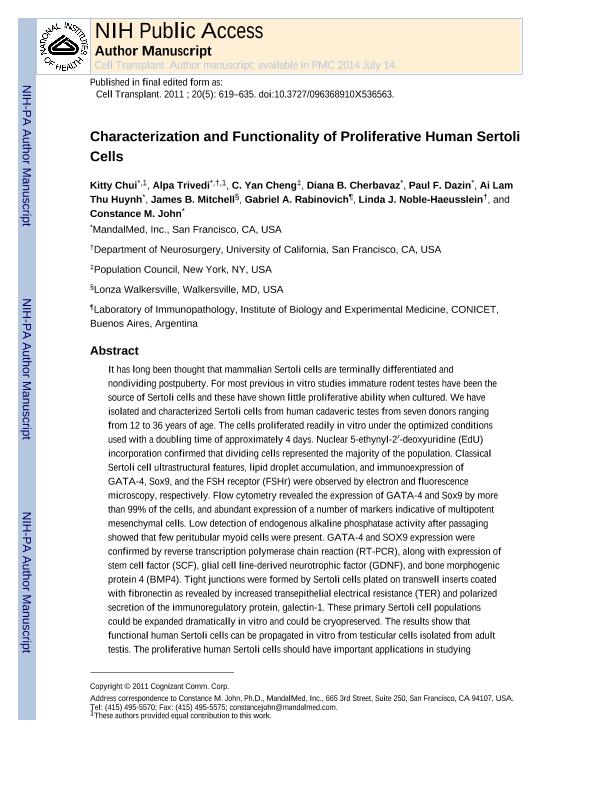Mostrar el registro sencillo del ítem
dc.contributor.author
Chui, Kitty
dc.contributor.author
Trivedi, Alpa
dc.contributor.author
Cheng, C. Yan
dc.contributor.author
Cherbavaz, Diana B.
dc.contributor.author
Dazin, Paul F.
dc.contributor.author
Huynh, Ai Lam Thu
dc.contributor.author
Mitchel, James B.
dc.contributor.author
Rabinovich, Gabriel Adrián

dc.contributor.author
Noble Haeusslein, Linda J.
dc.contributor.author
John, Constance M.
dc.date.available
2017-01-04T20:00:33Z
dc.date.issued
2011-05
dc.identifier.citation
Chui, Kitty; Trivedi, Alpa; Cheng, C. Yan; Cherbavaz, Diana B.; Dazin, Paul F.; et al.; Characterization and functionality of proliferative human sertoli cells; Cognizant Communication Corp; Cell Transplantation; 20; 5; 5-2011; 619-635
dc.identifier.issn
0963-6897
dc.identifier.uri
http://hdl.handle.net/11336/10837
dc.description.abstract
It has long been thought that mammalian Sertoli cells are terminally differentiated and nondividing postpuberty. For most previous in vitro studies immature rodent testes have been the source of Sertoli cells and these have shown little proliferative ability when cultured. We have isolated and characterized Sertoli cells from human cadaveric testes from seven donors ranging from 12 to 36 years of age. The cells proliferated readily in vitro under the optimized conditions used with a doubling time of approximately 4 days. Nuclear 5-ethynyl-2´-deoxyuridine (EdU) incorporation confirmed that dividing cells represented the majority of the population. Classical Sertoli cell ultrastructural features, lipid droplet accumulation, and immunoexpression of GATA-4, Sox9, and the FSH receptor (FSHr) were observed by electron and fluorescence microscopy, respectively. Flow cytometry revealed the expression of GATA-4 and Sox9 by more than 99% of the cells, and abundant expression of a number of markers indicative of multipotent mesenchymal cells. Low detection of endogenous alkaline phosphatase activity after passaging showed that few peritubular myoid cells were present. GATA-4 and SOX9 expression were confirmed by reverse transcription polymerase chain reaction (RT-PCR), along with expression of stem cell factor (SCF), glial cell line-derived neurotrophic factor (GDNF), and bone morphogenic protein 4 (BMP4). Tight junctions were formed by Sertoli cells plated on transwell inserts coated with fibronectin as revealed by increased transepithelial electrical resistance (TER) and polarized secretion of the immunoregulatory protein, galectin-1. These primary Sertoli cell populations could be expanded dramatically in vitro and could be cryopreserved. The results show that functional human Sertoli cells can be propagated in vitro from testicular cells isolated from adult testis. The proliferative human Sertoli cells should have important applications in studying infertility, reproductive toxicology, testicular cancer, and spermatogenesis, and due to their unique biological properties potentially could be useful in cell therapy.
dc.format
application/pdf
dc.language.iso
eng
dc.publisher
Cognizant Communication Corp

dc.rights
info:eu-repo/semantics/openAccess
dc.rights.uri
https://creativecommons.org/licenses/by-nc-sa/2.5/ar/
dc.subject
Sertoli Cells
dc.subject
Proliferation
dc.subject
Cell Cycle
dc.subject
Galectins
dc.subject.classification
Fisiología

dc.subject.classification
Medicina Básica

dc.subject.classification
CIENCIAS MÉDICAS Y DE LA SALUD

dc.title
Characterization and functionality of proliferative human sertoli cells
dc.type
info:eu-repo/semantics/article
dc.type
info:ar-repo/semantics/artículo
dc.type
info:eu-repo/semantics/publishedVersion
dc.date.updated
2016-12-30T13:43:26Z
dc.identifier.eissn
1555-3892
dc.journal.volume
20
dc.journal.number
5
dc.journal.pagination
619-635
dc.journal.pais
Estados Unidos

dc.journal.ciudad
Nueva York
dc.description.fil
Fil: Chui, Kitty. MandalMed Inc. ; Estados Unidos
dc.description.fil
Fil: Trivedi, Alpa. MandalMed Inc.; Estados Unidos. University of California; Estados Unidos
dc.description.fil
Fil: Cheng, C. Yan. Lonza Walkersville; Estados Unidos
dc.description.fil
Fil: Cherbavaz, Diana B.. MandalMed Inc.; Estados Unidos
dc.description.fil
Fil: Dazin, Paul F.. MandalMed; Estados Unidos
dc.description.fil
Fil: Huynh, Ai Lam Thu. MandalMed Inc.; Estados Unidos
dc.description.fil
Fil: Mitchel, James B.. Lonza Walkersville; Estados Unidos
dc.description.fil
Fil: Rabinovich, Gabriel Adrián. Consejo Nacional de Investigaciones Científicas y Técnicas. Instituto de Biología y Medicina Experimental. Fundación de Instituto de Biología y Medicina Experimental. Instituto de Biología y Medicina Experimental; Argentina
dc.description.fil
Fil: Noble Haeusslein, Linda J.. University of California; Estados Unidos
dc.description.fil
Fil: John, Constance M.. MandalMed Inc.; Estados Unidos
dc.journal.title
Cell Transplantation

dc.relation.alternativeid
info:eu-repo/semantics/altIdentifier/url/http://www.ingentaconnect.com/content/cog/ct/2011/00000020/00000005/art00003
dc.relation.alternativeid
info:eu-repo/semantics/altIdentifier/doi/http://dx.doi.org/10.3727/096368910X536563
dc.relation.alternativeid
info:eu-repo/semantics/altIdentifier/url/https://www.ncbi.nlm.nih.gov/pmc/articles/PMC4096632/
Archivos asociados
